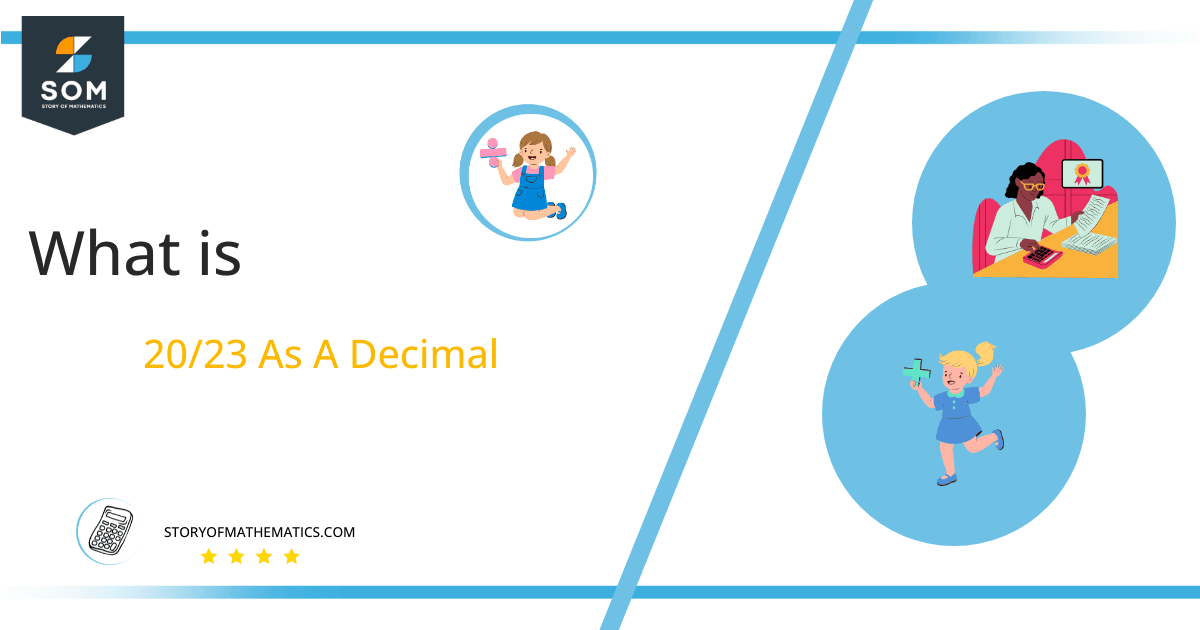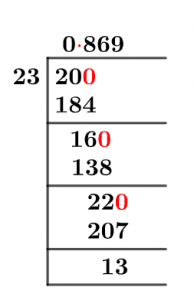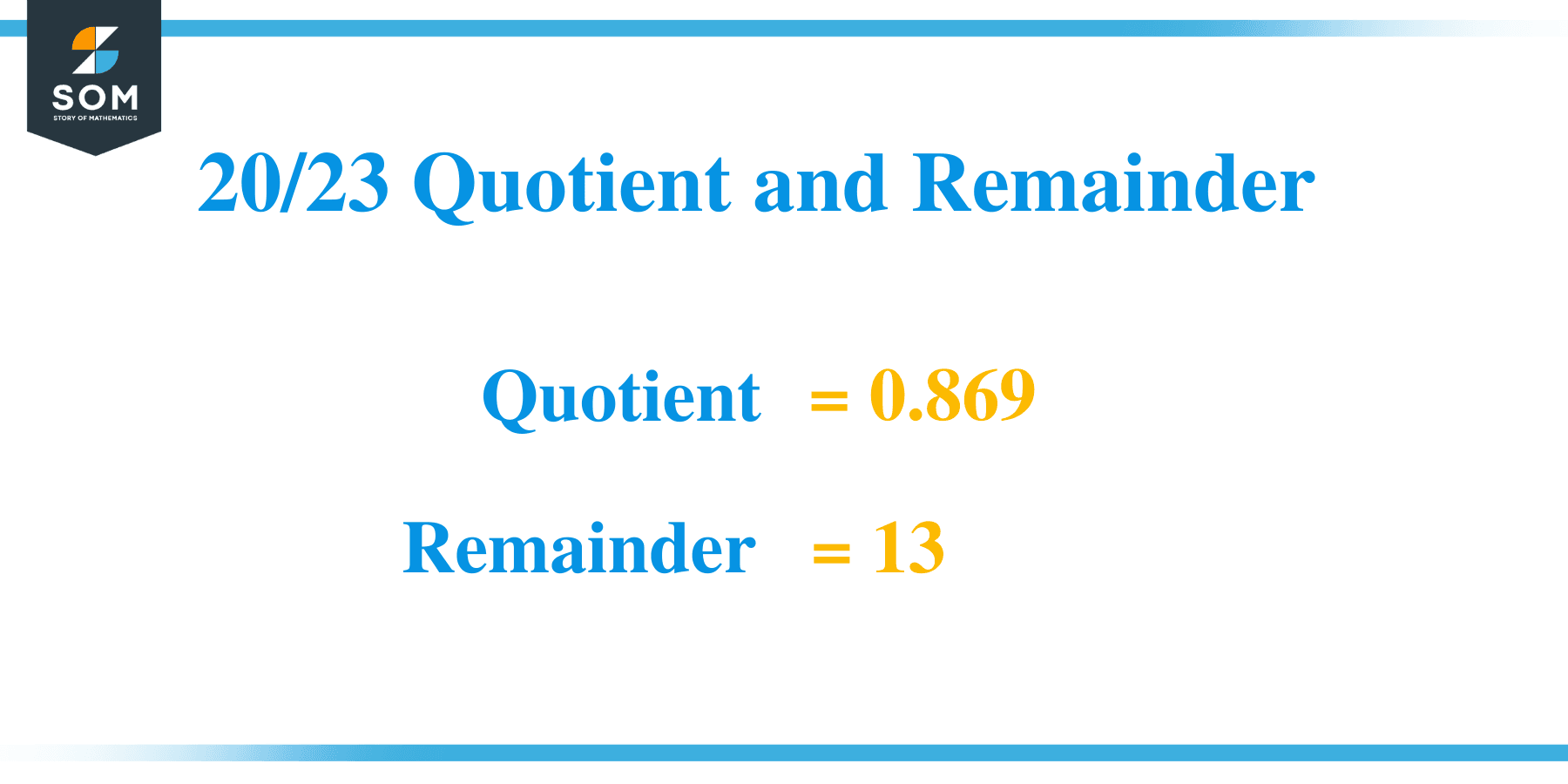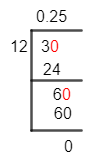JUMP TO TOPIC
What Is 20/23 as a Decimal + Solution With Free Steps
The fraction 20/23 as a decimal is equal to 0.869.
Decimals and Fractions are two methods for expressing any number. These two kinds can be converted into one another. A number is expressed in fractional form as the ratio of two non-zero values and in decimal form, as a number having a decimal point.
Here, we are more interested in the division types that result in a Decimal value, as this can be expressed as a Fraction. We see fractions as a way of showing two numbers having the operation of Division between them that result in a value that lies between two Integers.

Now, we introduce the method used to solve said fraction to decimal conversion, called Long Division, which we will discuss in detail moving forward. So, let’s go through the Solution of fraction 20/23.
Solution
First, we convert the fraction components, i.e., the numerator and the denominator, and transform them into the division constituents, i.e., the Dividend and the Divisor, respectively.
This can be done as follows:
Dividend = 20
Divisor = 23
Now, we introduce the most important quantity in our division process: the Quotient. The value represents the Solution to our division and can be expressed as having the following relationship with the Division constituents:
Quotient = Dividend $\div$ Divisor = 20 $\div$ 23
This is when we go through the Long Division solution to our problem, which can be seen in figure 1.

Figure 1
20/23 Long Division Method
We start solving a problem using the Long Division Method by first taking apart the division’s components and comparing them. As we have 20 and 23, we can see how 20 is Smaller than 23, and to solve this division, we require that 20 be Bigger than 23.
This is done by multiplying the dividend by 10 and checking whether it is bigger than the divisor or not. If so, we calculate the Multiple of the divisor closest to the dividend and subtract it from the Dividend. This produces the Remainder, which we then use as the dividend later.
Now, we begin solving for our dividend 20, which after getting multiplied by 10 becomes 200.
We take this 200 and divide it by 23; this can be done as follows:
200 $\div$ 23 $\approx$ 8
Where:
23 x 8 = 184
This will lead to the generation of a Remainder equal to 200 – 184 = 16. Now this means we have to repeat the process by Converting the 16 into 160 and solving for that:
160 $\div$ 23 $\approx$ 6
Where:
23 x 6 = 138
This, therefore, produces another Remainder which is equal to 160 – 138 = 22. Now we must solve this problem to Third Decimal Place for accuracy, so we repeat the process with dividend 220.
220 $\div$ 23 $\approx$ 9
Where:
23 x 9 = 207
Finally, we have a Quotient generated after combining the three pieces of it as 0.869=z, with a Remainder equal to 13.

Images/mathematical drawings are created with GeoGebra.
20/32 As A Decimal< Fractions to Decimals List > 18/32 As A Decimal
What Is 3/12 as a Decimal + Solution With Free Steps
The fraction 3/12 as a decimal is equal to 0.25.
Fraction is a term used to represent a small portion or piece of a whole object. For example, 1/4 means one-fourth of an object. If an object is divided into 4 equal parts, then 1/4 is the magnitude or size of one part.
A fraction is made up of two elements, the denominator and the numerator. Decimal value of any fraction can be found by division of numerator and denominator. In mathematical calculations, it is difficult to use fractions because these can cause confusion and also can prolong calculations. The solution to this problem is to use decimal values instead of fractions. The Decimal Value of any fraction can be found by division of numerator and denominator. It is a numeric value containing a Decimal Point.
In this section, we will try to understand the Long Division method for converting any fraction into its decimal value.
Solution
To resolve a fraction, one should have a deep understanding of division. In division, there are two important components, the Dividend, and the Divisor. A dividend is a number, which has to be split into smaller parts. On the other hand, the divisor is the number splitting the dividend.
When a fraction is solved, its component numerator is considered a dividend while the denominator is considered a divisor. So, for 3/12, we can write:
Dividend = 3
Divisor = 12
The decimal number or answer obtained after completing the process of division is called the Quotient.
Quotient = Dividend $\div$ Divisor = 3 $\div$ 12
A residual value at the end of the Division is called the Remainder. A non-zero value of remainder means that the number has not been completely divided.

Figure 1
3/12 Long Division Method
Nowadays, although the decimal value of any fraction can be determined using calculators in no time still it is necessary to learn the conventional division methods to solve the fractions. Long Division is an authentic method, which has no possibility of errors and provides us with accurate results.
Figure 1 shows the Long Division to solve 3/12.
3 $\div$ 12
We know that the division process requires dividends to be larger than divisors. But we have 3 which is smaller than 12, the divider. Thus, we add a zero to dividend 3 to make it 30 and a decimal point in the quotient.
30 $\div$ 12 \approx 2
12 x 2 = 24
A remaining value greater than zero is generated and is given as:
30 – 24 = 6
This 6 is made 60 by its multiplication with 10 to divide by 12.
60 $\div$ 12 = 5
12 x 5 = 60
As no residual is left behind so, 0.25 is determined decimal value of 3/12. It tells us that when 12 parts, each of size 0.25 are combined, we get a value of 3.
Images/mathematical drawings are created with GeoGebra.
